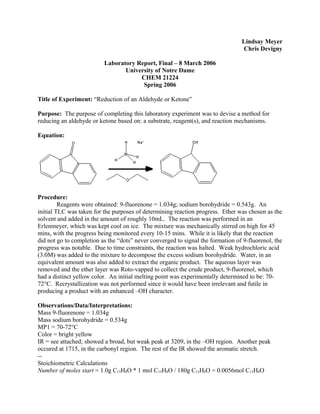
“Reduction of an Aldehyde or Ketone”
- 1. Lindsay Meyer Chris Devigny Laboratory Report, Final – 8 March 2006 University of Notre Dame CHEM 21224 Spring 2006 Title of Experiment: “Reduction of an Aldehyde or Ketone” Purpose: The purpose of completing this laboratory experiment was to devise a method for reducing an aldehyde or ketone based on: a substrate, reagent(s), and reaction mechanisms. Equation: Procedure: Reagents were obtained: 9-fluorenone = 1.034g; sodium borohydride = 0.543g. An initial TLC was taken for the purposes of determining reaction progress. Ether was chosen as the solvent and added in the amount of roughly 10mL. The reaction was performed in an Erlenmeyer, which was kept cool on ice. The mixture was mechanically stirred on high for 45 mins, with the progress being monitored every 10-15 mins. While it is likely that the reaction did not go to completion as the “dots” never converged to signal the formation of 9-fluorenol, the progress was notable. Due to time constraints, the reaction was halted. Weak hydrochloric acid (3.0M) was added to the mixture to decompose the excess sodium borohydride. Water, in an equivalent amount was also added to extract the organic product. The aqueous layer was removed and the ether layer was Roto-vapped to collect the crude product, 9-fluorenol, which had a distinct yellow color. An initial melting point was experimentally determined to be: 70- 72°C. Recrystallization was not performed since it would have been irrelevant and futile in producing a product with an enhanced –OH character. Observations/Data/Interpretations: Mass 9-fluorenone = 1.034g Mass sodium borohydride = 0.534g MP1 = 70-72°C Color = bright yellow IR = see attached; showed a broad, but weak peak at 3209, in the –OH region. Another peak occured at 1715, in the carbonyl region. The rest of the IR showed the aromatic stretch. -- Stoichiometric Calculations Number of moles start = 1.0g C13H8O * 1 mol C13H8O / 180g C13H8O = 0.0056mol C13H8O
- 2. Theoretical Yield = 0.0056mol C13H8O * (4mol C13H10O / 1mol C13H8O) * (178g C13H10O / 1 mol C13H10O) = 3.95g C13H10O Moles NaBH4 start = 0.0056mol C13H8O * 1mol NaBH4 / 4mol C13H8O) = 0.014mol NaBH4 Grams NaBH4 start = 0.014mol NaBH4 * 37.84g NaBH4 / 1mol NaBH4 = 0.5298g NaBH4 -- The melting point of the product, what was to be 9-fluorenol, was lower than the expected value for the reagent, 9-fluorenone. A critical appraisal of the experimental techniques showed that the correct quantities of reagents were used (see stoichiometric calculations above). The disparity was likely introduced in the sodium borohydride, a reagent that quickly decomposes in air. Taking reagent from a weigh boat near the balance was a poor idea, because it had probably been saturated and rendered useless, in terms of reactivity. This explains the melting point of the “product” – a figure that was less than the expected melting point of the starting material. Impurities were introduced which ultimately lowered the melting point. The “peak” we see in the –OH region, could possibly be due to residual water in the product. The sodium borohydride was mostly to blame in this experiment in terms of error. In the future, recalling this unfruitful experience, will serve as a helpful reminder to take care in controlling reagents, especially those that decompose. However, the process that was used to reduce the ketone to an alcohol was in principle correct. The methodology was sound, a good solvent was chosen, and the measurements were correct. The final “product” – as it was obtained from Roto-vapping off the ether solvent, was likely mostly reagent 9-fluorenone, based on the melting points and an IR of functional groups. The carbonyl peak was very distinct and large, whereas the alcohol peak was not distinct, and may have been due to water. The unknown factor in this experiment was the extent to which sodium borohydride decomposed. It seems that nearly all of it was useless, based on the amount of –OH character seen in the IR spectrum. Repeating this experiment under much tighter controls would prevent any future problems regarding reagent reactivity. With the developed procedure, future attempts would most likely produce 9-fluorenol, the alcohol, in much higher yields. This could be determined again, with an IR, and taking a melting point. The theoretical melting point for 9-fluorenol is 152-158°C and we would expect the melting point to be slightly under that value (to account for unavoidable impurities introduced experimentally). Recrystallization would also be utilized, to help purify the product further. In this trial, recrystallization was not attempted as it would not have been useful. The –OH character was so weak, that perhaps recrystallization would have introduced additional impurities that would have degraded the alcoholic nature of the product. Although this is debatable, it is certainly a delicate balance and again – very unnecessary since there wasn’t a lot of physical 9-fluorenol product to purify. Essentially, the entire procedure was one extended purification of 9-fluorenone, and recrystallization would not have rendered any more alcohol product, from the predominating ketone.
